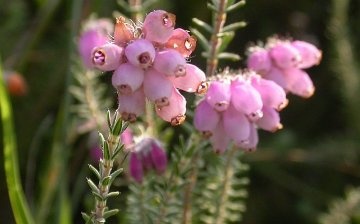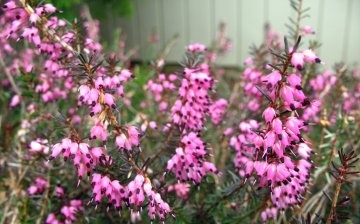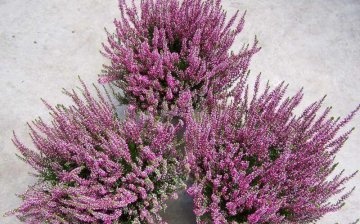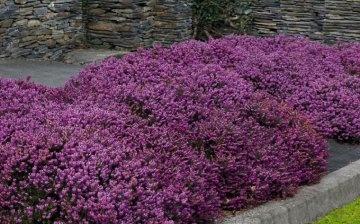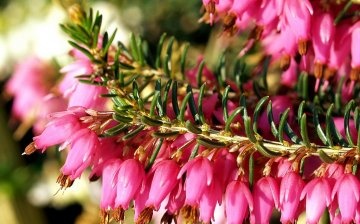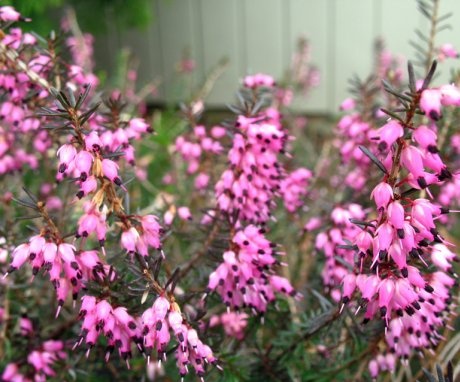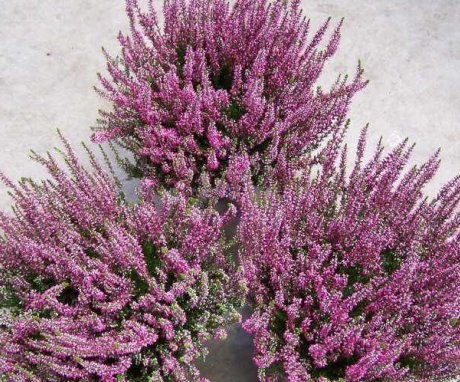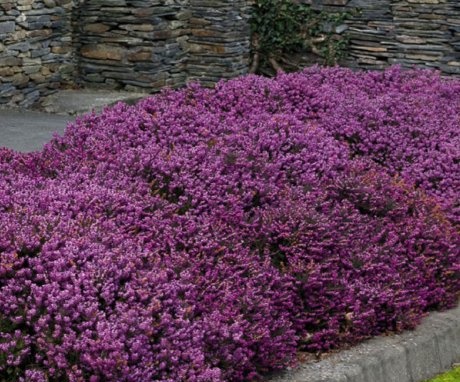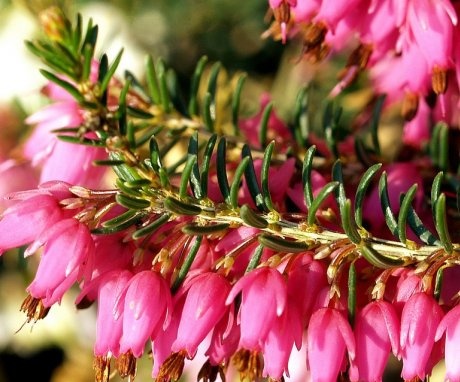Eric's plant: breeding methods and care features
Erika is a very attractive plant. This flower is often used to decorate flower beds, local areas, gardens, parks, squares. Plants are characterized not only by their attractive appearance, but also by their ease of care, which makes them very popular among gardeners.
Content:
Description of the plant
Erica is characterized by the presence of over 400 species. Most of the flowers are classified as herbaceous plants. Erica is a great evergreen bush... This plant is characterized by the presence of needle-like leaves that have a delicate green color. It can change by winter in some plant species.
Erica has long stems that are stiff and erect.
The flowering of this plant begins in the autumn. The color of flowers can be varied: white, red, pink, yellow, crimson, lilac, etc. During the flowering period, the plant is covered with small flowers so densely that its leaves are practically invisible. The color of flowers after flowering persists for a long time.
Features of reproduction of Erica
Plant propagation can be done in the following ways:
Erica has very small seeds, which requires planting them indoors. To do this, you need to prepare plastic dishes or boxes with earth. Seeds are sown on the surface of the soil and are not covered with it. Before sprouting, the container with seeds is covered with glass or foil. To ensure friendly and dense seedlings, it is necessary to correctly select the soil.
To prepare the soil for planting Erica, you need to take one part of coniferous and heather land, sand and two parts of peat.
All soil components are thoroughly mixed. In order to get seedlings as quickly as possible, it is necessary to provide a room temperature of 18-20 degrees. It is necessary to wait for seedlings 30 days after planting the seeds. In the first week, it is necessary to maintain high humidity. The plant must also be allowed to breathe periodically by opening the glass or film for 5-10 minutes.
In early spring, Erica can be propagated using apical cuttings:
- Reproduction of the plant must be done before flowering or after one month.
- So that the cuttings are not damaged diseases and did not fade, it is necessary to choose fairly tough cuttings. Their length should be within 2-3 centimeters. One third of the resulting cuttings are immersed in the substrate.
- To ensure rapid reproduction of the plant, it is necessary to choose a substrate that includes sphagnum peat and sand.
- It will be best to initially plant the flower in a pot, which will allow its root system to form correctly.
- After Erica disembarks, she is provided with regular top dressing... For this purpose, microfertilizers or a weak urea solution are used.
- The first roots on the plant are formed after 3-4 weeks.
A fairly effective method of plant propagation is the division of the bush. Initially, you need to dig up an old bush and divide it into several parts using a shovel.After disembarking parts of Erica, they need to ensure timely care and weeding.
Erica's care
In order to preserve the intense color of the plant, it must be planted in sunny places. If Erica grows in partial shade, then her flowers will be pale and flowering is poor. The plant must be protected from the effects of the wind. For this purpose, it is very often planted hedges.
For planting Erica, it is necessary to choose an almost neutral soil, but acidic soils are most suitable for her. That is why peat and sand are added to the soil before planting the plant.
Watering the plant:
- Only soft water should be used to water the plant.
- At watering the plants are required to maintain the temperature regime.
- From time to time, it is necessary to add various liquid fertilizers to the water.
- The terrestrial part of the erica should be sprayed periodically to maintain optimum moisture content.
- The soil around the plant must be constantly moist.
- When the plant dries up, it is watered abundantly.
- If Erica is grown in a pot, then it can be placed in water together with the pot for half an hour.
After wintering, the plant must be transplanted into another pot without fail, having previously prepared a new soil. It should be characterized by a large amount of peat, moderate acidity and the absence of lime impurities.
After transplanting the plant, the top layer of soil, which is located above the roots, is well compacted.
Erica's appearance plays an important role, so it also needs to be carefully monitored. After the plant has faded, dried flowers are removed from it. To do this, you just need to turn Erica on its side and russ the flowers.
Pruning plants:
- This plant needs pruning after flowering.
- This action is performed to form bushes.
- Thanks to pruning, the plant will have a lush bush and abundant flowering for the next year.
- Only the green part of the plant, which is characterized by the presence of leaves, is cut off.
- This plant does not form new shoots in adulthood, so pruning is done in such a way as not to damage the lignified branches.
- To ensure the natural appearance of the bush, the shoots are trimmed at different levels. If it is produced symmetrically, then the plant will lose its attractive appearance.
The plant is not very afraid of frost, but under the conditions of its cultivation in a harsh climate, it must be properly prepared for wintering. To do this, in the autumn, peat or dry foliage is added to the near-stem circles of the plant. The upper part of the plant is covered with spruce branches, which allows it to be protected from frost, to limit moisture from condensation. Also, with the help of spruce branches, you can increase the acidity of the soil, which will favorably affect the growth and development of Erica.
Plant pests and diseases
Erica is not actually hurt pests... The plant can succumb to fungal and viral diseases. Most often, gray rot is observed in Eric. The development of the disease occurs as a result of high humidity. That is why it is necessary not to plant the plant in those places that are characterized by the accumulation of water or melted snow. With late removal of the shelter or improper creation of it, plants can also be damaged by gray rot.
In the presence of gray rot, a gray bloom appears on the plants, the foliage disappears, and the young shoots die off.
If you see at least one of these signs, then it is imperative to fight gray mold using antifungal insecticides. These drugs include Fendazole, Topaz. If the disease attacks Erica very strongly, then a 1% solution of copper sulfate can be used to combat it. It is necessary to treat the plant with insecticides 2-3 times.The interval can be from 5 to 10 days. In the autumn or spring period, you can prevent the disease using these drugs.
Erica is very beautiful perennial, the care of which is to carry out trimming, glazepreparing for wintering. With the correct implementation of all these actions, you can ensure the full growth and development of the plant.
More information can be found in the video.



